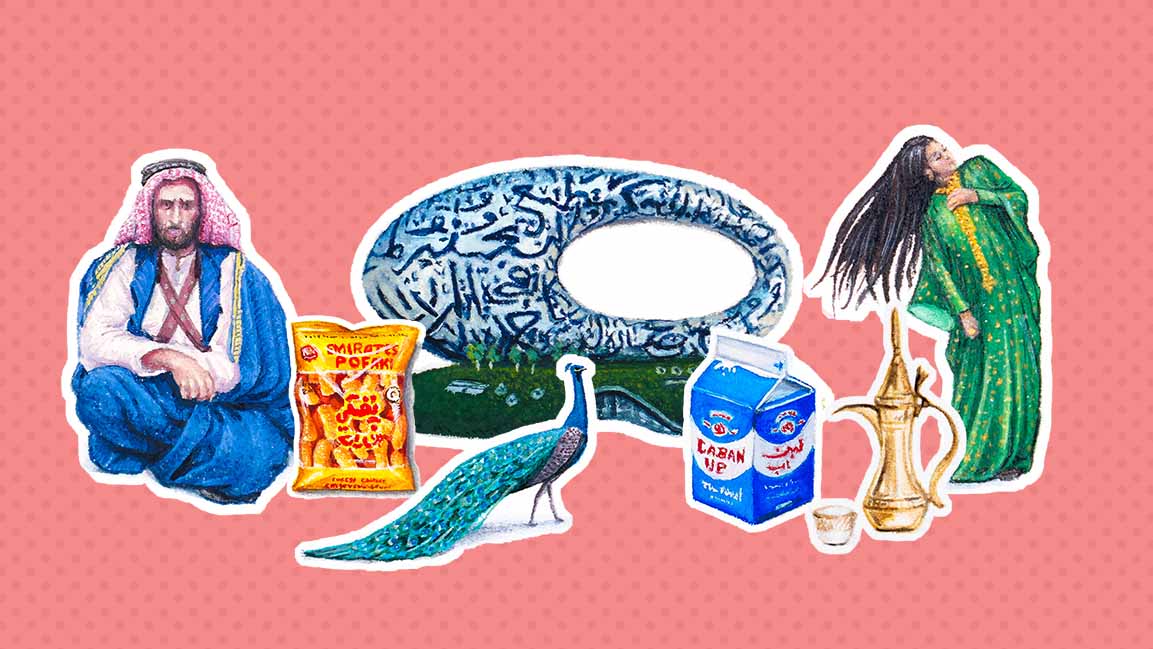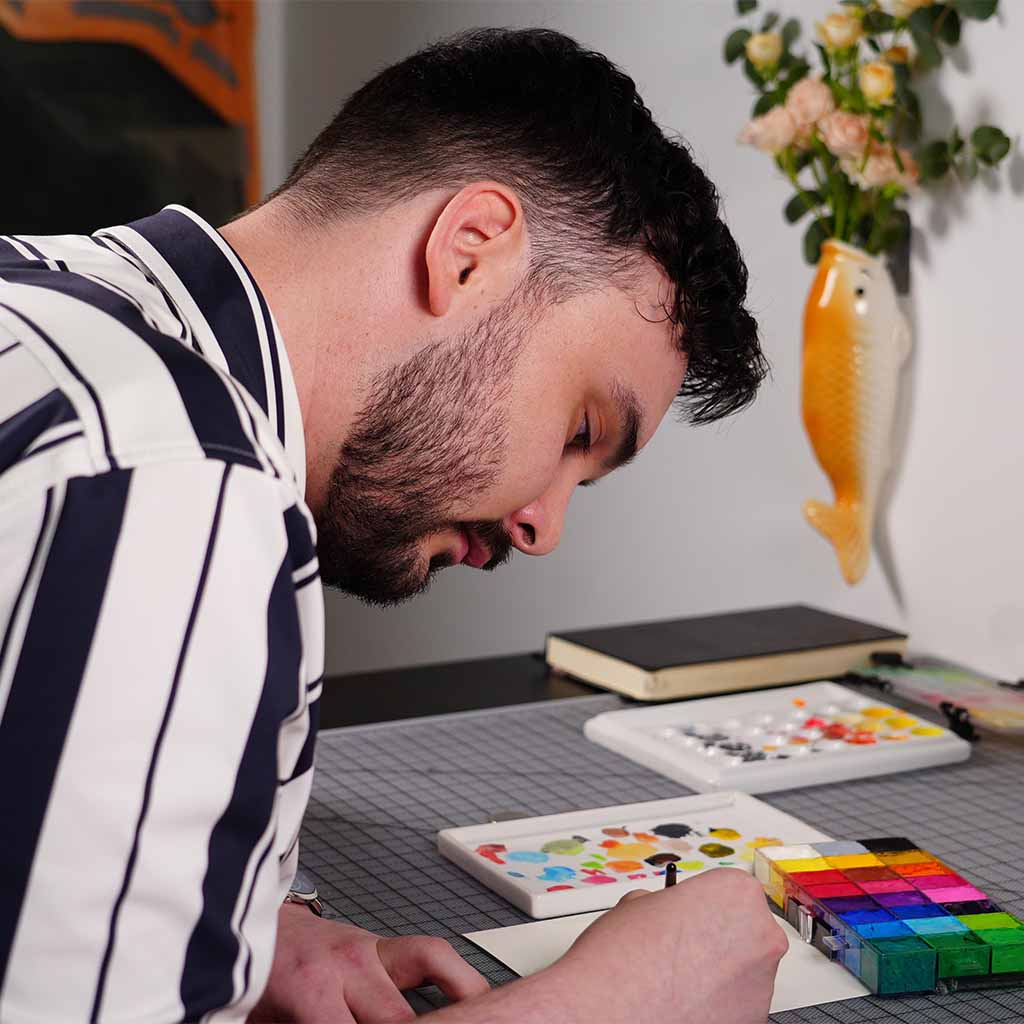- | 3:03 pm
This artist transforms the ordinary into extraordinary with dirham-sized art
Through intricate, dirham-sized artworks, Mason Rempfer celebrates the iconic and overlooked elements that define UAE culture

Lugaimat, Laban Up, a yellow school bus—what everyday objects capture the essence of the United Arab Emirates? It’s evident that there are countless examples. Artist Mason Rempfer reveals the rich tapestry of Emirati history and culture through the ordinary items often overlooked—the familiar yet uncelebrated aspects of daily life.
“Items that are overlooked are deeply woven into the fabric of daily life and would be missed if one were to leave,” says Rempfer. His exhibition, Behind the Dirham, presented by Khawla Art Gallery, marks a milestone as the gallery’s first show featuring an artist from outside the MENA region.
“My goal was to capture the essence of everyday life – the small moments and simple pleasures that can be taken for granted. While seemingly mundane, these objects are integral to what makes the UAE unique and specific to its people,” Rempfer says.
Interestingly, Rempfer used the dirham coin as his canvas to highlight the beauty of these everyday items. “The dirham, as an object, is something so ordinary—just a piece of loose change that we handle every day—yet it’s intricately detailed and often overlooked,” he says.
As a coin collector, the artist reveals that the dirham was his first tangible connection to the UAE and became a personal keepsake.
“I wanted to show that no single object or memory is more important than another; we all gather small tokens of nostalgia, and that idea became the foundation for this series,” he adds.
The team at Khawla Art and Culture suggested the exhibition’s name. Rempfer felt it was a perfect fit—not only because of the scale of the pieces but also for its deeper meaning, encouraging viewers to look beyond the dirham to explore the UAE’s cultural identity.
UNCOVERING THE EXTRAORDINARY

Mason Rempfer/Khawla Art Gallery
Overall, Rempfer’s exhibition offers a distinct exploration of Emirati culture through intricately crafted miniature artworks, each no larger than a dirham coin. His approach blends iconic symbols with intimate details of everyday life, creating a deeply personal yet universally relatable narrative.
Rempfer describes his process as adopting an “anthropological mindset.” When documenting a culture, it’s not just about showcasing what society is proud of, like its landmarks, but also capturing the habits, foods, objects, nostalgia, history, flora, fauna, and everyday moments that truly define life.
“You can’t fully capture a culture by focusing only on famous symbols.”
This approach allowed him to go beyond the surface, portraying the UAE through an outsider’s lens while capturing the familiar, essential aspects of daily life for its residents.
His goal is not just to highlight cultural icons like traditional architecture but also to illuminate lesser-known elements. “I wanted to examine the UAE from an outsider’s perspective while also documenting what’s familiar and integral to everyday life,” he says, aiming for a balance between well-known cultural symbols and the smaller, often overlooked moments.
For those unfamiliar with the UAE, the exhibition offers a mix of nostalgia and discovery. “The small moments I’ve captured have a universal appeal—they resonate with anyone, whether they know the UAE or not,” he adds.
Rempfer hopes viewers will connect through recognition or a sense of wonder. During the exhibit’s opening dinner, he and his gallery team transformed the space into a sensory time capsule, immersing guests with nostalgic elements like old TVs and iconic childhood snacks such as Vimto and Laban Up, which was the perfect journey back in time to the simple life of a bygone era.
One of the exhibition’s strengths is its dynamic resonance. With 138 individually painted miniatures on display, each piece contributes to a larger narrative. “The emotional depth of this series is amplified by the sheer number of artworks, with each one contributing to a larger tapestry of memories and moments,” Rempfer says.
The exhibit is curated by theme, inviting visitors to journey through various aspects of Emirati life. One section celebrates nostalgic childhood snacks; another highlights the UAE’s flora and fauna. At the same time, a personal favorite for Rempfer features objects from a traditional grandmother’s home, such as a tin chocolate box repurposed for sewing supplies and other cherished trinkets.
Rempfer envisions evolving his work to focus more on the human interest stories. “Moving forward, I’d like to focus on documenting these personal stories, shifting from objects to the individuals behind them,” he says.
With the support of Khawla Art and Culture, Rempfer plans to take future exhibitions to a global audience, further strengthening the connection between art and the UAE’s cultural identity.
Explore Rempfer’s artworks at Khawla Art Gallery, D3, which is open to visitors until October 18, 2024.





































